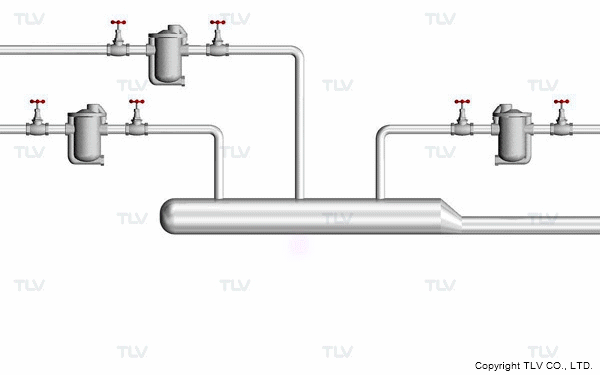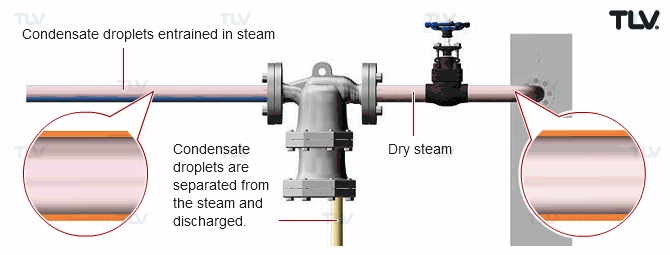- Home
- Steam Resources
- Steam Theory
- Erosion in Steam and Condensate Piping
Steam Trap Problems
Erosion in Steam and Condensate Piping
Erosion is a physical process that refers to the gradual wearing away of a solid through abrasion. This article will focus on erosion in steam and condensate piping, a common problem in steam plants wherein sections of piping are eroded away causing significant steam leakage.
| Steam Leak Caused by Pipe Erosion |
|---|
|
|
| Erosion causes the thinning of the pipe wall that can eventually lead to holes in piping, causing live steam leaks that can be a serious safety hazard. |
What Causes Erosion?
Water both entrained in steam flow and also as non-discharged condensate traveling at high speeds in piping is the source of most erosion. By repeatedly impacting piping at bends, the water can cause the gradual thinning of the pipe wall due to its mass and high velocity of impact, similar to what occurs in industrial water jet cutting. This type of erosion - caused by water droplets - is typically known as Liquid Droplet Impingement (LDI) Erosion.
In many cases, but particularly with carbon steel piping, erosion can remove the protective inner piping surface treatment thereby speeding the electrochemical thinning of the pipe wall, a process know as corrosion. In fact, both erosion and corrosion typically work together to cause the thinning of the steam pipe inner wall.
Piping Damage Caused by Erosion
Resistance to erosion varies according to the material. For reasons related to cost and installation, carbon steel piping is typically used as standard practice in most steam distribution lines even though it isn't as resistant as stainless steel piping. Use of stainless steel piping is usually limited to pharmaceutical, biotech, clean steam, or other sterile applications.
| Erosion Occurring in Piping |
|---|
|
|
| As liquid droplets hit the inner wall of the pipe, the wall slowly wears away. |
Some surface treatments can offer carbon steel piping protections against corrosion, but these aren't as resistant as those for stainless steel. The treatments can temporarily protect the steel to slow down erosion and corrosion.
However, once thinning caused by erosion starts to occur, additional thinning of the pipe wall can occur even more rapidly. This is because the high velocity water not only physically breaks down the impacted region of the steel piping, but also accelerates corrosion by removing the surface treatments that protect the piping.
Other Types of Erosion in Steam and Condensate Piping
Erosion in steam and condensate piping is not limited to the above-mentioned erosion caused by liquid droplet impingement (LDI) or high velocity dis-entrained condensate.
Condensate recovery piping in particular can be susceptible to erosion from improperly handled flash steam that occurs in the discharge stream. Indeed, even though condensate piping is designed for condensate transport, the process of flash re-vaporization can result in an environment very similar to steam distribution piping containing a large volume of high velocity wet steam. This type of LDI erosion is often called "flashing erosion".
Flashing erosion can often be worsened by two related factors:
- Undersized condensate return lines that cause high flash steam velocity (water-cutting effect)
- Corrosive elements such as carbonic acid that can be associated with low temperature condensate
Additionally, "cavitation erosion" can occur from the sudden shock wave impacts caused by the implosion of small liquid-free zones within condensate. Cavitation erosion occurs because flash steam can occupy a very large volume, but then suddenly and rapidly condense after a portion of its heat is lost, having been transferred to the adjacent fluid or piping.
Due to specific volume differences between steam and condensate, the sudden condensation of flash steam can create a large void that is rapidly and often violently filled by adjacent condensate, thereby causing shock waves known as water hammer. The rapid collapse of the flash volume and associated shock caused by high velocity condensate filling the void can lead to significant piping erosion and damage.
Erosion Countermeasures
Countermeasures for Limiting Erosion in Condensate Recovery Piping
Limiting erosion in condensate recovery piping requires multiple design considerations. One crucial element is to size the condensate return pipe large enough to accommodate steam and condensate two-phase flow, as discussed here:
Condensate recovery piping is typically designed using the average rate of condensate flow. However, if steam traps that operate intermittently are used, such as bucket, disc, piston, and thermostatic type traps, then the momentary discharge rate can be much greater than the calculated average. This can result in a much higher condensate flow velocity than anticipated, which may lead to greater erosion of the piping.
| Erosion at Trap Outlet |
|---|
|
|
|
|
| Traps that operate intermittently may lead to greater erosion of piping at the trap outlet. |
In such cases, the options are to locate the trap further upstream and away from the direction change, eliminate direction changes where possible, over-size the discharge pipe if cost effective, or select a trap with a more continuous type discharge such as a Free Float® or float design.
Countermeasures for Limiting Erosion in Steam Distribution Piping
Preventing erosion in steam distribution piping is generally a more simple matter, and typically requires the removal of water droplets entrained within the steam. This involves the installation of a steam-condensate separator.
| Steam Separator |
|---|
|
|
| Condensate entrained in steam is mechanically removed using a steam separator. |
Although steam supplied through the boiler can have a high percent of dryness, all boilers without super heater sections still contain certain amounts of condensate entrained in the steam that is created. Condensate also forms from radiation heat loss throughout the distribution piping. For these reasons, it is critically important to both install traps at regular intervals and install separators that mechanically remove water droplets from steam in required areas.






